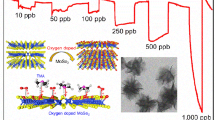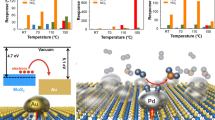Abstract
Due to its unique physical, chemical and surface electronic properties, molybdenum disulfide (MoS2) nanosheets open up a new avenue for nitrogen dioxide (NO2) detection at room temperature. Nevertheless, the gas sensing properties of pure MoS2 nanosheets are inevitably degenerated by the adsorption of atmospheric oxygen, which results in weak stability for MoS2-based gas sensors. Reducing surface defects and constructing heterojunctions may be effective strategies to improve the gas sensing properties of MoS2 nanosheets. In this work, we design a novel nanocomposite based on MoS2 nanosheets decorated with tin disulfide (SnS2) nanoparticles (MoS2/SnS2) via combining the mechanical exfoliation method with the facile hydrothermal method. The experimental results indicate that, after surfaces decoration with SnS2 nanoparticles, the as-prepared gas sensor based on MoS2/SnS2 nanocomposites exhibits reliable long-term stability with the maximum response value drift of less than 3% at room temperature. Moreover, the MoS2/SnS2 sensor also possesses desirable gas sensing properties upon NO2 at room temperature, such as high sensitivity, rapid response/recovery speed (28 s/3 s, 5 × 10−6 NO2), satisfactory selectivity, favorable repeatability and reversibility. The improved gas sensing properties of MoS2/SnS2 nanocomposites can be attributed to the unique electronic properties of MoS2 nanosheets with the fewer layers structure and the competitive adsorption effect of SnS2 nanoparticles. This work elucidates that SnS2 nanoparticles serving as an effective antioxidative decoration can promote the stability of MoS2 nanosheets, providing a promising approach to achieve high-stability NO2 gas sensors at room temperature.





Similar content being viewed by others
References
Yang ZM, Zhang DZ, Chen HN. MOF-derived indium oxide hollow microtubes/MoS2 nanoparticles for NO2 gas sensing. Sens Actuators B Chem. 2019;300:127037.
Fan YY, Tu HL, Pang Y, Wei F, Zhao HB, Yang Y, Ren TL. Au-decorated porous structure graphene with enhanced sensing performance for low-concentration NO2 detection. Rare Met. 2020;39(6):651.
Zhang H, Feng JC, Fei T, Liu S, Zhang T. SnO2 nanoparticles-reduced graphene oxide nanocomposites for NO2 sensing at low operating temperature. Sens Actuators B Chem. 2014;190:472.
Xiao Y, Yang QY, Wang ZY, Zhang R, Gao Y, Sun P, Sun YF, Lu GY. Improvement of NO2 gas sensing performance based on discoid tin oxide modified by reduced graphene oxide. Sens Actuators B Chem. 2016;227:419.
Zhang WY, Hu M, Liu X, Wei YL, Li N, Qin YX. Synthesis of the cactus-like silicon nanowires/tungsten oxide nanowires composite for room-temperature NO2 gas sensor. J Alloys Compd. 2016;679:391.
Chaloulakou A, Mavroidis I, Gavriil I. Compliance with the annual NO2 air quality standard in Athens. Required NOx levels and expected health implications. Atmos Environ. 2008;42(3):454.
Si KP, Meng LJ, Gong YJ. Fabrication methods and properties of two-dimensional group VB transition metal dichalcogenides. Chin J Rare Met. 2019;43(11):1164.
Zhang DZ, Wu JF, Li P, Cao YH. Room-temperature SO2 gas-sensing properties based on a metal-doped MoS2 nanoflower: an experimental and density functional theory investigation. J Mater Chem A. 2017;5(39):20666.
Zhang WD, Dong XA, Liang Y, Liu R, Sun YJ, Dong F. Synergetic effect of BiOCl/Bi12O17Cl2 and MoS2: in situ DRIFTS investigation on photocatalytic NO oxidation pathway. Rare Met. 2019;38(5):437.
Lu HH, Shi CS, Zhao NQ, Liu EZ, He CN, He F. Carbon and few-layer MoS2 nanosheets co-modified TiO2 nanosheets with enhanced electrochemical properties for lithium storage. Rare Met. 2018;37(2):107.
Li H, Wu J, Yin ZY, Zhang H. Preparation and applications of mechanically exfoliated single-layer and multilayer MoS2 and WSe2 nanosheets. Acc Chem Res. 2014;47(4):1067.
Zhang SW, Yang HC, Gao HH, Cao RY, Huang JZ, Xu XJ. One-pot synthesis of CdS irregular nanospheres hybridized with oxygen-incorporated defect-rich MoS2 ultrathin nanosheets for efficient photocatalytic hydrogen evolution. ACS Appl Mater Interfaces. 2017;9(28):23635.
Wu J, Li H, Yin ZY, Li H, Liu JQ, Cao XH, Zhang Q, Zhang H. Layer thinning and etching of mechanically exfoliated MoS2 nanosheets by thermal annealing in air. Small. 2013;9(19):3314.
Bhimanapati GR, Hankins T, Lei Y, Vilá RA, Fuller I, Terrones M, Robinson JA. Growth and tunable surface wettability of vertical MoS2 layers for improved hydrogen evolution reactions. ACS Appl Mater Interfaces. 2016;8(34):22190.
Zhu H, Qin XY, Cheng LX, Azcatl A, Kim JY, Wallace RM. Remote plasma oxidation and atomic layer etching of MoS2. ACS Appl Mater Interfaces. 2016;8(29):19119.
Santosh KC, Longo RC, Wallace RM, Cho KJ. Surface oxidation energetics and kinetics on MoS2 monolayer. J Appl Phys. 2015;117(13):135301.
Li WL, Zhang Y, Long X, Cao JX, Xin X, Guan XX, Peng JF, Zheng XJ. Gas sensors based on mechanically exfoliated MoS2 nanosheets for room-temperature NO2 detection. Sensors. 2019;19(9):2123.
Xu YS, Zheng W, Liu XH, Zhang LQ, Zheng LL, Yang C, Pinna N, Zhang J. Platinum single atoms on tin oxide ultrathin film for extremely sensitive gas detection. Mater Horiz. 2020;7(6):1519.
Xu YS, Ma TT, Zheng LL, Sun L, Liu XH, Zhao YQ, Zhang J. Rational design of Au/Co3O4-functionalized W18O49 hollow heterostructures with high sensitivity and ultralow limit for triethylamine detection. Sens Actuators B Chem. 2019;284:202.
Zhu ZY, Zheng LJ, Zheng SZ, Chen J, Liang MH, Tian YT, Yang DC. Cr doped WO3 nanofibers enriched with surface oxygen vacancies for highly sensitive detection of the 3-hydroxy-2-butanone biomarker. J Mater Chem A. 2018;6(43):21419.
He B, Ren YX, Dai TJ, Hou S, Liu XZ. Characterization and performance of graphene–PbSe thin film heterojunction. Rare Met. 2019. https://doi.org/10.1007/s12598-019-01344-w.
Tan JJ, Hu JY, Ren JX, Peng JF, Liu C, Song YQ, Zhang Y. Fast response speed of mechanically exfoliated MoS2 modified by PbS in detecting NO2. Chin Chem Lett. 2020;31(8):2103.
Cui SM, Wen ZH, Huang XK, Chang JB, Chen JH. Stabilizing MoS2 nanosheets through SnO2 nanocrystal decoration for high-performance gas sensing in air. Small. 2015;11(19):2305.
Huang YF, Jiao WC, Chu ZM, Nie XM, Wang RG, He XD. SnS2 quantum dots based optoelectronic flexible sensor for ultrasensitive detection of NO2 down to one-ppb. ACS Appl Mater Interfaces. 2020;12(22):25178.
Ou JZ, Ge WY, Carey B, Daeneke T, Rotbart A, Shan W, Wang YC, Fu ZQ, Chrimes AF, Wlodarski W, Russo SP, Li YX, Kalantar-zadeh K. Physisorption-based charge transfer in two-dimensional SnS2 for selective and reversible NO2 gas sensing. ACS Nano. 2015;9(10):10313.
Zhang Q, Zhang H, Xu MK, Shen ZR, Wei Q. A WO3 nanorod-Cr2O3 nanoparticle composite for selective gas sensing of 2-butanone. Chin Chem Lett. 2018;29(3):538.
Li C, Yu ZS, Fang SM, Wang HX, Gui YH, Xu JQ, Chen RF. Fabrication and gas sensing property of honeycomb-like ZnO. Chin Chem Lett. 2008;19(5):599.
Herrero AM. Raman spectroscopy a promising technique for quality assessment of meat and fish: a review. Food Chem. 2008;107(4):1642.
Ji JH, Xiao YF, Shen B, Yi QY, Zhang JL, Xing MY. Magnetic separation of metal sulfides/oxides by Fe3O4 at room temperature and atmospheric pressure. Rare Met. 2019;38(5):379.
Utyuzh AN, Timofeev YA, Stepanov GN. Effect of pressure on raman spectra of SnS2 single crystals. Phys Solid State. 2010;52(2):352.
Zhang Y, Zou HF, Peng JF, Duan ZH, Ma M, Xin X, Li WL, Zheng XJ. Enhanced humidity sensing properties of SmFeO3-modified MoS2 nanocomposites based on the synergistic effect. Sens Actuators B Chem. 2018;272:459.
Zheng SZ, Zheng LJ, Zhu ZY, Chen J, Kang JL, Huang ZL, Yang DC. MoS2 nanosheet arrays rooted on hollow rGO spheres as bifunctional hydrogen evolution catalyst and supercapacitor electrode. Nano Micro Lett. 2018;10(4):62.
Hu L, Song XF, Zhang SL, Zeng HB, Zhang XJ, Marks R, Shan D. MoS2 nanoparticles coupled to SnS2 nanosheets: the structural and electronic modulation for synergetic electrocatalytic hydrogen evolution. J Catal. 2018;366:8.
Hu YY, Bai YL, Wu XY, Wei X, Wang KX, Chen JS. MoS2 nanoflakes integrated in a 3D carbon framework for high-performance sodium-ion batteries. J Alloys Compd. 2019;797:1126.
Zhai CY, Zhu MS, Bin D, Ren FF, Wang CQ, Yang P, Du YK. Two dimensional MoS2/graphene composites as promising supports for Pt electrocatalysts towards methanol oxidation. J Power Sources. 2015;275:483.
Lu L, Min FX, Luo ZH, Wang SQ, Fei T, Li GH, Feng CQ. Synthesis and electrochemical properties of tin-doped MoS2 (Sn/MoS2) composites for lithium ion battery applications. J Nanopart Res. 2016;18(12):357.
Zhang DZ, Xu ZY, Yang ZM, Song XS. High-performance flexible self-powered tin disulfide nanoflowers/reduced graphene oxide nanohybrid-based humidity sensor driven by triboelectric nanogenerator. Nano Energy. 2020;67:104251.
Wan KC, Wang D, Wang F, Li HJ, Xu JC, Wang XY, Yang JH. Hierarchical In2O3@SnO2 core-shell nanofiber for high efficiency formaldehyde detection. ACS Appl Mater Interfaces. 2019;11(48):45214.
Long H, Harley-Trochimczyk A, Pham T, Tang ZR, Shi TL, Zettl A, Carraro C, Worsley MA, Maboudian R. High surface area MoS2/graphene hybrid aerogel for ultrasensitive NO2 detection. Adv Funct Mater. 2016;26(28):5158.
Park W, Park J, Jang J, Lee H, Jeong H, Cho K, Hong S, Lee T. Oxygen environmental and passivation effects on molybdenum disulfide field effect transistors. Nanotechnology. 2013;24(9):095202.
Wang ZY, Von dem Bussche A, Qiu Y, Valentin TM, Gion K, Kane AB, Hurt RH. Chemical dissolution pathways of MoS2 nanosheets in biological and environmental media. Environ Sci Technol. 2016;50(13):7208.
Nan HY, Wang ZL, Wang WH, Liang Z, Lu Y, Chen Q, He DW, Tan PH, Miao F, Wang XR, Wang JL, Ni ZH. Strong photoluminescence enhancement of MoS2 through defect engineering and oxygen bonding. ACS Nano. 2014;8(6):5738.
Rout CS, Joshi PD, Kashid RV, Joag DS, More MA, Simbeck AJ, Washington M, Nayak SK, Late DJ. Enhanced field emission properties of doped graphene nanosheets with layered SnS2. Appl Phys Lett. 2014;105(4):043109.
Popov I, Seifert G, Tománek D. Designing electrical contacts to MoS2 monolayers: a computational study. Phys Rev Lett. 2012;108(15):156802.
Li WR, Xu HY, Zhai T, Yu HQ, Chen ZR, Qiu ZW, Song XP, Wang JQ, Cao BQ. Enhanced triethylamine sensing properties by designing Au@SnO2/MoS2 nanostructure directly on alumina tubes. Sens Actuators B Chem. 2017;253:97.
Zhang DZ, Yang ZM, Yu SJ, Mi Q, Pan QN. Diversiform metal oxide-based hybrid nanostructures for gas sensing with versatile prospects. Coordin Chem Rev. 2020;413:213272.
Xin X, Zhang Y, Guan XX, Cao JX, Li WL, Long X, Tan X. Enhanced performances of PbS quantum-dots-modified MoS2 composite for NO2 detection at room temperature. ACS Appl Mater Interfaces. 2019;11(9):9438.
Han YT, Ma YJ, Liu Y, Xu SS, Chen XW, Zeng M, Hu NT, Su YJ, Zhou ZH, Yang Z. Construction of MoS2/SnO2 heterostructures for sensitive NO2 detection at room temperature. Appl Surf Sci. 2019;493:613.
Liu LJ, Ikram M, Ma LF, Zhang XY, Lv H, Ullah M, Khan M, Yu HT, Shi KY. Edge-exposed MoS2 nanospheres assembled with SnS2 nanosheet to boost NO2 gas sensing at room temperature. J Hazard Mater. 2020;393:122325.
Tai HL, Yuan Z, Zheng WJ, Ye ZB, Liu CH, Du XS. ZnO nanoparticles/reduced graphene oxide bilayer thin films for improved NH3-sensing performances at room temperature. Nanoscale Res Lett. 2016;11(1):1.
Wang X, Li Y, Li ZY, Zhang SW, Deng XL, Zhao G, Xu XJ. Highly sensitive and low working temperature detection of trace triethylamine based on TiO2 nanoparticles decorated CuO nanosheets sensors. Sens Actuators B Chem. 2019;301:127019.
Wang X, Wang TK, Si GK, Li Y, Zhang SW, Deng XL, Xu XJ. Oxygen vacancy defects engineering on Ce-doped α-Fe2O3 gas sensor for reducing gases. Sens Actuators B Chem. 2020;302:127165.
Zhao SJ, Xue JM, Kang W. Gas adsorption on MoS2 monolayer from first-principles calculations. Chem Phys Lett. 2014;595:35.
Miller DR, Akbar SA, Morris PA. Nanoscale metal oxide-based heterojunctions for gas sensing: a review. Sens Actuators B Chem. 2014;204:250.
Zhang DZ, Jiang CX, Li P, Sun Y. Layer-by-layer self-assembly of Co3O4 nanorod-decorated MoS2 nanosheet-based nanocomposite toward high-performance ammonia detection. ACS Appl Mater Interfaces. 2017;9(7):6462.
Zhang DZ, Sun Y, Li P, Zhang Y. Facile fabrication of MoS2-modified SnO2 hybrid nanocomposite for ultrasensitive humidity sensing. ACS Appl Mater Interfaces. 2016;8(22):14142.
Acknowledgements
This study was financially supported by Hunan Provincial Natural Science Foundation of China (No. 2018JJ2404), the Scientific Research Foundation of Hunan Provincial Education Department (Nos. 19A475 and 19C1739) and Hunan Science and Technology Plan Program (No. 2019RS1056).
Author information
Authors and Affiliations
Corresponding authors
Rights and permissions
About this article
Cite this article
Liu, JB., Hu, JY., Liu, C. et al. Mechanically exfoliated MoS2 nanosheets decorated with SnS2 nanoparticles for high-stability gas sensors at room temperature. Rare Met. 40, 1536–1544 (2021). https://doi.org/10.1007/s12598-020-01565-4
Received:
Revised:
Accepted:
Published:
Issue Date:
DOI: https://doi.org/10.1007/s12598-020-01565-4




